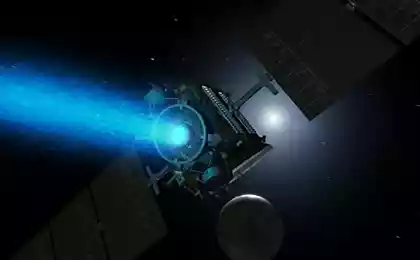768
Dawn continues to explore white spots Ceres
More and more new parts discovers Dawn interplanetary probe on the surface of the dwarf planet Ceres, throwing up new puzzles researchers.
Since the beginning of June 2015 the probe Dawn is on the so-called research orbit of Ceres. He is currently engaged in shooting the surface of the dwarf planet with a resolution of 400 meters. From the resulting images will be drawn up the first detailed map with data on the height of the relief. Some of the probe sent images of studied celestial body has come as a surprise to scientists.

© NASA / JPL-Caltech / UCLA / MPS / DLR / IDA i> sup>
On one of the detailed pictures can be discerned an unusual hill that looks like a volcanic crater without a cone. This hill is a little lighter than the surrounding landscape. Cone sharply in favor of the cratered surface and a central peak impact crater. Presumably, it could be formed as a result of geological activity dwarf planet.
Since 2004 on the fuzzy images of the Hubble were found bright spots of Ceres, astronomers are trying to determine their origin.
Dawn brought a detailed view of one of these spots, on the basis of which we can conclude that this bright spot was the result of the impact of another celestial body smaller.
Light is the substance inside is well preserved and apparently newly formed crater, and in the surrounding ejected mass. Most likely, the body blows struck the upper crust of Ceres and exposed material having a different composition. It is expected that more accurate information is received by the infrared spectrometer VIR, which is also on board the Dawn.

© NASA / JPL-Caltech / UCLA / MPS / DLR / IDA i> sup>
It is less likely that a light material belonged fallen body. It crashed into the Ceres with great speed and was stalled for a split second. The energy dramatically transformed into heat, the body vanished and left a crater on Ceres explosive. Typically, the temperature of an asteroid impact in the tens of thousands of degrees achieved almost instantly.
At year end, Dawn will orbit 400 km, which will detect objects of a surface about 35 meters in diameter. This will involve the third tool Dawn - detection of neutrons and gamma rays, GRaND.
The surface of Ceres is subject to constant bombardment by cosmic rays. In the upper surface of the accumulated material micrometers secondary radiation, which can detect GRaND. This will create a table distributions major rock-forming chemical elements: oxygen, magnesium, aluminum, silicon, titanium, and iron. It will also be possible to determine the emission of long-lived radioactive elements, such as potassium-40, thorium-232 and uranium-238. In addition, neutrons incident on the surface, will detect the presence of gases such as hydrogen, carbon and nitrogen.
These studies definitively clarify whether there is ice on the surface of Ceres.
Source: geektimes.ru/post/252270/
Since the beginning of June 2015 the probe Dawn is on the so-called research orbit of Ceres. He is currently engaged in shooting the surface of the dwarf planet with a resolution of 400 meters. From the resulting images will be drawn up the first detailed map with data on the height of the relief. Some of the probe sent images of studied celestial body has come as a surprise to scientists.

© NASA / JPL-Caltech / UCLA / MPS / DLR / IDA i> sup>
On one of the detailed pictures can be discerned an unusual hill that looks like a volcanic crater without a cone. This hill is a little lighter than the surrounding landscape. Cone sharply in favor of the cratered surface and a central peak impact crater. Presumably, it could be formed as a result of geological activity dwarf planet.
Since 2004 on the fuzzy images of the Hubble were found bright spots of Ceres, astronomers are trying to determine their origin.
Dawn brought a detailed view of one of these spots, on the basis of which we can conclude that this bright spot was the result of the impact of another celestial body smaller.
Light is the substance inside is well preserved and apparently newly formed crater, and in the surrounding ejected mass. Most likely, the body blows struck the upper crust of Ceres and exposed material having a different composition. It is expected that more accurate information is received by the infrared spectrometer VIR, which is also on board the Dawn.

© NASA / JPL-Caltech / UCLA / MPS / DLR / IDA i> sup>
It is less likely that a light material belonged fallen body. It crashed into the Ceres with great speed and was stalled for a split second. The energy dramatically transformed into heat, the body vanished and left a crater on Ceres explosive. Typically, the temperature of an asteroid impact in the tens of thousands of degrees achieved almost instantly.
At year end, Dawn will orbit 400 km, which will detect objects of a surface about 35 meters in diameter. This will involve the third tool Dawn - detection of neutrons and gamma rays, GRaND.
The surface of Ceres is subject to constant bombardment by cosmic rays. In the upper surface of the accumulated material micrometers secondary radiation, which can detect GRaND. This will create a table distributions major rock-forming chemical elements: oxygen, magnesium, aluminum, silicon, titanium, and iron. It will also be possible to determine the emission of long-lived radioactive elements, such as potassium-40, thorium-232 and uranium-238. In addition, neutrons incident on the surface, will detect the presence of gases such as hydrogen, carbon and nitrogen.
These studies definitively clarify whether there is ice on the surface of Ceres.
Source: geektimes.ru/post/252270/























